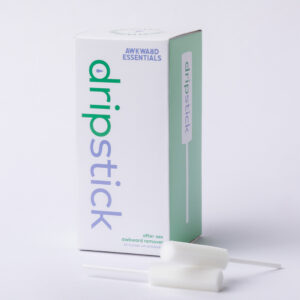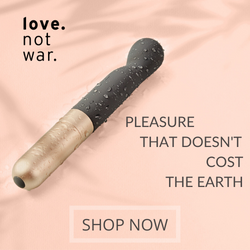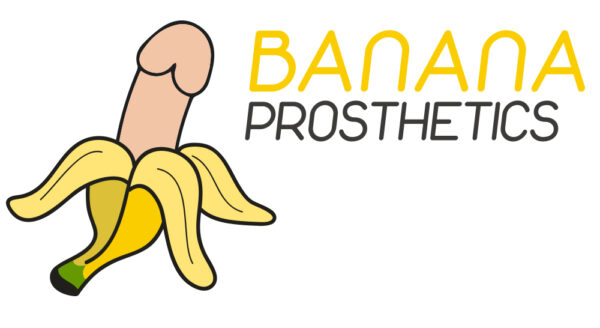Touchbot Debuts ‘Lattice’ Dildo Handle Shaped by Sex Toy User Insights
SexForEveryBody.com is supported by our readers. We may earn a commission if you buy through links on our site. Learn more.

Disability-led startup Touchbot unveiled “Lattice” earlier this year, an ergonomic sex toy handle created based on survey feedback from both disabled and non-disabled respondents.
Described as an adaptive reach product, the 3D-printed Lattice is compatible with the brand’s own Deep Sea line of silicone dildos.
The long sex toy handle also supports Soul Source vaginal dilators. These sexual health devices are used for pelvic floor physical therapy, an area of sexual wellness that’s often inaccessible to people with limited range of motion or larger bodies.
The Touchbot team includes Margaret Andersen, a queer and disabled graphic designer and journalist frustrated by the lack of accessible sex tech options, and Alex, a nanotechnology engineer, synthesis, and maker.
Back in 2021, the startup announced it was developing a line of accessible pleasure products, and was seeking feedback from both disabled and non-disabled people on sex toy design needs.
We caught up with Margaret Andersen of Touchbot to learn more about the Lattice dildo handle, survey findings on accessible sex toy design, and what’s next for the company.
Q&A with Touchbot Co-founder
What did you discover from the survey results on accessible sex toy designs?

MA: “Results from our sex toy design survey showed that 75% of our respondents who identified as disabled wanted sex toys with better reach and longer handles. They expressed an overall dissatisfaction with currently available options, and indicated a strong desire for a wider range of accessible pleasure products.
“This aligned with results from a similar survey conducted by The Christopher and Dana Reeve Foundation in 2015, in which 70% of respondents reported that their disability had affected their sexual health. We also found that a large percentage of non-disabled respondents also expressed interest in using sex toys with better reach and longer handles, often relating to chronic pain, body size, or for older adults.”
How did the survey results influence your decision-making for Touchbot’s next steps?
MA: “It confirmed for us that Lattice needed to be a modular system, something that could easily adapt to the needs of each user. Disability is not a monolith, and so accessible products cannot be designed through a one-size-fits-all method.”
Can you describe what the Lattice device is and how it will work with dilators?
MA: “Lattice is an angle adjustable reach extension handle that is modular by design, so you can mix and match different lengths to suit your body. We offer our own line of dilators that connect directly to Lattice via our patent-pending coupler system, and we also have an adapter ring set that secures other dilator brands to Lattice. Our new toy line connects in the same way as our dilators, and we just released two adapters that allow you to use Lattice with any toy from your current collection that has a suction cup base or a vac-u-loc base.”
Why do you use 3D printing to create Touchbot products and do you plan to continue to in the future?

MA: “3D printing is a rapidly growing industry that is revolutionizing the way products are designed, prototyped, and manufactured. It’s being implemented in a wide range of industries, from healthcare to automotive, and we think it will eventually become more widely adopted in the sextech industry.
“Currently, most sexual wellness products are still produced using traditional manufacturing methods which are costly and difficult to customize. For example, if you already own a set of dilators that don’t match the size of our adapter rings, we’re able to 3D print custom sizes at little to no extra cost. It also allows us to produce highly complex designs (like lattice structure in our handles) that just wouldn’t be possible if we were using conventional production methods.
“3D gives us more freedom to adapt our products to our customers’ needs rather than the other way around. I’m all for devising DIY disability hacks for everyday products, but we shouldn’t have to; especially for intimate, personal care products like sex toys and dilators.”
Can you tell me more about why you started Touchbot and came to co-founder it with Alex?
MA: “I personally needed an extension handle when I used dilators for pelvic pain a few years ago. Because of my disability and limited range of motion in my arms, inserting dilators independently was an impossible task. It was also deeply frustrating that this was yet another access barrier to sexual health that folks with disabilities face.
“There was literally nothing on the market that would give me the leverage and length I needed to complete my pelvic floor therapy program, so I DIY’d a version (after a trip to Home Depot!) which worked well enough for me to insert the dilators myself.
“That was the lightbulb moment that made me realize there are probably a lot of people like me who need more angle adjustability and reach than what the current dildo and dilator handles on the market can offer. I have a background in design, and my partner Alex is an engineer.
“We both had a strong interest in utilizing 3D printing to design assistive technology devices. And since sextech is fundamentally assistive tech, we knew with our combined experience we had a unique opportunity to create a sextech product line that uses accessibility as the guiding principle.
“We’ve spent the last two years developing our extension handle system which is now patent-pending. Our handles are 3D printed, lightweight, and modular, allowing users to mix and match different lengths and attach a variety of our toys and dilators to the base.”
What other sexual wellness products or sex toys does Touchbot plan to launch?
MA: “We plan to expand our product line with powered and non-powered toys, as well as additional adapters, ergonomic supports and extensions to increase the usability of our products to folks with a broader spectrum of abilities. And that’s just the beginning! We’re excited to continue to grow a product ecosystem that is modular and adaptable, and accessible.”
Previous sex toy survey findings

After the Touchbot team put out its survey calling for feedback on accessible sex toy handles and designs, they released some initial findings in 2021.
At that time, these were the most requested features and improvements to sex toys currently on the market:
- longer handles that provided better reach
- lighter weight designs
- easier buttons for powered toys
- wrist straps to keep toys from slipping during use
- easier ways to charge
According to Touchbout, their goal has been to expand thinking “on how the toys and tools we build can create pleasurable experiences for all body/minds.” For that reason, they’ve sought feedback from all sex toy users, not just people who identify as having a disability, in order to improve everyone’s sex toy experience in terms of access, ease of use, and sex toy ergonomics.
For information on more handles for sex toys, you may want to read our list of best dildo handles and ergonomic sex toy handles,

Jenna Owsianik is a Canadian journalist and sex tech industry expert. She is the Founder and Editor-in-Chief of Sex For Every Body®.
Her expertise covers state-of-the-art sex technologies and the major fields driving innovations in intimacy: robotics, virtual reality, remote sex (teledildonics), haptics, immersive adult entertainment, human augmentation, virtual sex, and sexual health.
A trained journalist with a Masters of Journalism from The University of British Columbia, Jenna’s reporting has appeared on Futurism.com, Al Jazeera English, CTV British Columbia online, CBS Sunday Morning, CBS 60 Minutes, Global News, and CKNW Radio in Canada and the United States.












